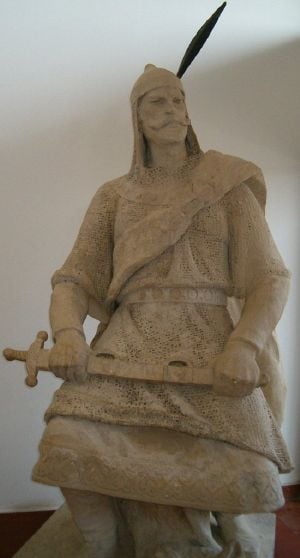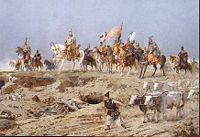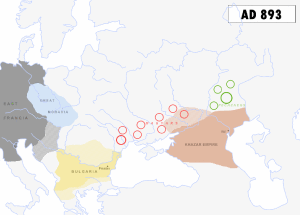Árpád
Árpád (c. 845 – c. 907), the second Grand Prince of the Magyars (c. 895 – c. 907). Under his rule the Magyar people moved from Etelkoz to the Carpathian basin. The dynasty descending from him ruled the Magyar tribes and later the Kingdom of Hungary until 1301. While he is not the father of Hungary, he did establish the dynasty that would shape the life of the Magyar people for several centuries. He may have been spiritual as well as temporal leader; this period was before the Hungarians converted to Christianity towards the end of the tenth century. His descendant, Stephen I of Hungary, canonized as Saint Stephen, became the first King of Hungary in 1001 ending the succession of Grand Princes. The
His life
. Árpád was the son of Prince Álmos, leader of the Hungarian tribal federation based in Etelkoz, where they had migrated from their homeland in the Urals; his mother's name and descent is unknown. According to Hungarian tradition, he was descended from Attila the Hun, possibly his great-great-grandchild. By 894, he was strong enough militarily to offer support to the Byzantine Empire despite being subject to the suzerainty of the Khazars. Meeting with representatives of the Emperor, Leo IV the Wise he negotiated the terms under which the confederation of the Magyar tribes was willing to assist the Byzantine Empire against Emperor Simeon I of Bulgaria.
In the spring of next year, the Magyar tribes attacked the Bulgarian Empire and defeated Emperor Simeon I, forcing him to conclude peace with the Byzantine Empire. Emperor Simeon, however, entered into an alliance with the Pechenegs instead, who were the eastern neighbours of the Hungarian tribal federation, and he then attacked the Magyar troops. In the Battle of Southern Buh, Emperor Simeon I defeated their army; shortly afterwards, the Pechenegs attacked as well and pillaged their territories. The Magyar tribes were obliged to move to the Carpathian Basin, where they settled (Honfoglalás).. This completed the Magyars long migration form their original homeland in the Urals.
The circumstances of Álmos' death in 895 are unclear. He may have been assassinated or even offered as a human sacrifice to atone for losing the war. The leaders of the seven Hungarian tribes proclaimed Árpád as Grand Prince of the Magyars making him the first the hold this title (although his father is sometimes referred to as the first Grand Prince.); therefore Árpád is considered traditionally to have lead the Honfoglalás, "the occupation of the country".
In 896 the Hungarian tribes occupied the Upper Tisza river, from there they undertook numerous looting raids in central and western Europe, and in 900/901 they moved to Pannonia[1]. The Magyars entering the Pannonian fields in 896 may have represented about 200,000–250,000 people.
Based on Arabic sources, Árpád's title, like his father's, seems to have been kende[2] or gyula. In that time kende was the spiritual leader of the Magyar tribes, while the gyula led their military campaigns. According to legends, Árpád hold the first "parliamentary" session with 40 other "nobles" on horseback before 900 C.E.
Children
- Levente
- Tarhos (Tarkacsu) (? – ?)
- Üllő (Jeleg or Jeleg) (? – ?)
- Jutocsa (Jutas) (? – ?)
- Zoltan of Hungary (947 – ?)
Legacy
Although he is not considered the founder of the Kingdom of Hungary – that was his descendant Stephen I –, he is generally thought of as the forefather of Hungarians and is often affectionaly mentioned as our father Árpád. Árpád was the founder of the dynasty named after him, which would rule over the kingdom of Hungary until 1301.
Grand Princes of the Magyars
- Álmos (c. 855 – c. 895)
- Árpád (c. 895– c. 907)
- Unknown(s) / Zoltán (Zaltasz) (? – ?)
- Fajsz (c. 950)
- Taksony (c. 955 – c. 973)
- Géza (c. 973 – 997)
- Stephen (Vajk) (997 – 1000/1001)
Notes
ReferencesISBN links support NWE through referral fees
- Balázs, György, and Károly Szelényi. 1989. The Magyars: the birth of a European nation. [Budapest]: Corvina.ISBN 9789631327106
- Bartha, Antal. 1975. Hungarian society in the 9th and 10th centuries. Budapest: Akadémiai Kiadó.ISBN 9789630503082
- Engel, Pál. 2001. The realm of St. Stephen: a history of medieval Hungary, 895-1526. London: I.B. Tauris.ISBN 9781860640612
- Kosztolnyik, Z. J. 2002. Hungary under the early Árpáds, 890s to 1063. East European monographs, no. 605. Boulder, CO: East European Monographs. ISBN 9780880335034
Credits
New World Encyclopedia writers and editors rewrote and completed the Wikipedia article in accordance with New World Encyclopedia standards. This article abides by terms of the Creative Commons CC-by-sa 3.0 License (CC-by-sa), which may be used and disseminated with proper attribution. Credit is due under the terms of this license that can reference both the New World Encyclopedia contributors and the selfless volunteer contributors of the Wikimedia Foundation. To cite this article click here for a list of acceptable citing formats.The history of earlier contributions by wikipedians is accessible to researchers here:
The history of this article since it was imported to New World Encyclopedia:
Note: Some restrictions may apply to use of individual images which are separately licensed.


